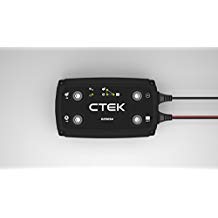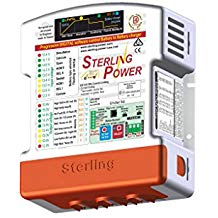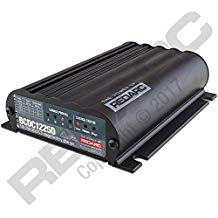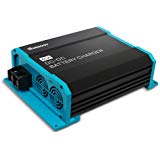User Tools
This is an old revision of the document!
Table of Contents
Battery to battery chargers
A b2b (or dc-dc) charger is a type of isolator that boosts charging voltage to the house battery. These typically cost more and are rated for less current than normal isolator types.1)
 This kind of controller boosts the chassis voltage to voltage appropriate for proper lead-acid Absorption.
This kind of controller boosts the chassis voltage to voltage appropriate for proper lead-acid Absorption.
limitations
Lead-acid batteries require two things to get fully charged:
- a high enough Absorption voltage (Vabs)
- enough time at that voltage for the battery to stop accepting much current.2)
DC-DC chargers address the first requirement, but unless you are driving for hours the isolator still won't have enough time to fully charge the batteries. DC-DC chargers were first marketed for cruisers (powered boats) since they run the engines (“cruise”) for hours each day.
Charger throughput is generally limited to 20-30A since higher rates would dictate $$$ internal components. This isn't as big a limitation as it might seem, since lead-acid current acceptance drops substantially throughout Absorption. Untested theory: b2b chargers might work well beside normal isolators; this is essentially the $$$ CTEK SmartPass setup described below.
sizing
DC-DC chargers come in different ratings (10A, 40A, 60A, etc) which increase significantly in price as the rating increases.
Bigger is not always better, since battery types accept current at different rates and buying more charging capacity than the battery wants3) is a waste. Assuming a 100Ah battery:
- Flooded lead-acid accepts a maximum of about C/5, or 20A and requires a minimum of C/10 (10A). In this case, 10-20A of charging capacity would be appropriate. Less than 10A would be insufficient for battery health and more than 20A would be wasted expense.
- AGM lead-acid accepts a max of about C/3, or 33A per 100A of battery capacity, and requires a minimum of C/5 (20A). In this case, 20-33A of charging capacity would be appropriate. Less than 20A would be insufficient for battery health and more than 33A would be wasted expense.
- Lithium has very low internal resistance, and may be able to slurp up all the alternator has to give. However, for the following reasons an appropriate charging capacity for lithium would be as small as possible while still meeting your power needs:
- added expense
- lithium does not care about partial states of charge
- lithium tends to last longest with gentler charging/discharging
- the alternator will be happier with lighter loading
common examples
CTEK D250 series
The most common b2b charger with 'dwellers is the CTEK D250SA, a 20A solar/alt controller. It has connections for both alternator and solar panel input + MPPT function, although the MPPT algo may not be partcularly robust.
House and starter batteries are combined when the starter battery holds >13.1v for 5 seconds.4) The batteries are isolated when the starter battery is “<12.8V, for 10 sec… or service battery voltage > starter battery voltage”.
The SmartPass accessory adds 80A of alternator-voltage charging when Vbatt is low enough that the alternator can still charge it directly. This combined charging5) will happen in the first half of Bulk mode. As house battery voltage rises to normal alternator voltage the smartpass can no longer contribute. At that point the 20A D250SA continues voltage-boosted charging to Absorption voltage.6)
Note: the CTEK D250SA7) panel voltage (Vpanel) maximum is 23v.8) There are user reports that the unit is repairable after overvoltage or polarity damage.9),10)
The MPPT charger will charge the house battery at up to 20A. CTEK specifies 50-300W of panel, though the 23v Vmax limits the unit to [electrical:solar:panels#panel_voltage|nominal 12v panels]. Note: polycrystalline panels may be more useful here, as their Voc should be a bit lower than mono.
The D250SA trickle charges the starter battery from a solar panel at intervals of 3 seconds if the service battery is fully charged.11)
Note: in 2020 CTEK added the D250SE and Smartpass 120S which have lithium settings.
Sterling
 The Sterling Pro Batt Ultra series is alternator-charging only, but can be configured to exact setpoints. The BB1260-12 is a 30A example and costs about $50 more than the D250S above.
The Sterling Pro Batt Ultra series is alternator-charging only, but can be configured to exact setpoints. The BB1260-12 is a 30A example and costs about $50 more than the D250S above.
Renogy
- DCC-series of voltage sensing b2b chargers in 20A and 40A versions.
- DCC50S 50A model with MPPT charging. MPPT input limited to 25v.14) - manual (pdf) The 50A may refer to 25A MPPT and 25A alternator charging.15)
Redarc
 Redarc makes a 25A b2b charge with MPPT similar to the CTEK.
Redarc makes a 25A b2b charge with MPPT similar to the CTEK.
Ring Automotive
Ring makes a 30A DC-DC charger with 50v max input MPPT. (manual)
Kisae
Kisae makes a DMT1230 DC-DC charger 30A charger with 45v MPPT input. They also make a 50A model (DMT1250).
Customer support is generally regarded as excellent.
FlexCharge
The FlexCharge NC25a-12 is a 25A charger that claims exceptional efficiency16), the ability to dump loads, and a proprietary charging algorithm.



